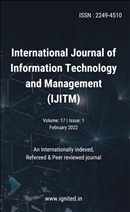Development and architecture of Customer Relationship Management on Predictive Analytics in Smart Utilities Based
Main Article Content
Authors
Abstract
The study's scope is restricted with regard to the topics that are covered, the locations thatare covered, and the analyses that are covered. Given that the researcher's focus was on customerrelationship management, which is just one aspect of the marketing process, the topical scope of thestudy was therefore constrained. Again, concentrating on a few of the numerous units that make uporganisations in an area couldn't disclose any more details about the research. The research is focusedon the Smart Utilities based on Predictive Analytics, and because the consumers of the business aredispersed in the various areas, the geographical scope of the study is restricted because of this. Anotherconstraint of the study is its geographical or regional scope. There is also an analytical restriction to theresearch, which is that the proposed customer engagement methods are only supplied when theemphasis is focused on the predefined goals. It was also observed that customer relationshipmanagement is the most neglected activity in many organizations, which should be given prime attentionto meet the contemporary challenges in Smart Utilities based on Predictive Analytics. Therefore the needis to make in-depth study of how the relationship aspect will affect the growth profitability for the firms to what extent this requires an in-depth study of the subject entitled with intention to make acomprehensive study of customer relationship management in Smart Utilities based on PredictiveAnalytics.
Downloads
Download data is not yet available.
Article Details
Section
Articles
References
- Abdul-Muhmin, A. (2012). CRM technology use & implementation benefits in an emerging market. Journal of Database Marketing; Customer Strategy Management, 19(7), 82-97.
- Agariya, A., & Singh, D. (2013). CRM index: An effective weapon for relationship enhancement. International Journal of Financial Services Management, 6(3), 179-199.
- Baran, R., & Galka, R. (2013). CRM: The foundation of contemporary marketing strategy. New York, NY: Routledge.
- Crnkovic, J. (2013). Invited Article: The Future of CRM is UX. Business Systems Research, 4(1), 4-13.
- Heyn, J. (2012). CRM – How it can help medium size companies & are there any downsides to its implementation. München: GRIN Verlag GmbH.
- Jamieson, C. (2014). Small Business’ Guide to Social CRM. Packt Publishing.
- Josiassen, A., Assaf, A., & Cvelbar, L. (2014). CRM & the bottom line: Do all CRM dimensions affect firm performance? International Journal of Hospitality Management, 36(7), 130-136.
- Kaufmann, H. (2013). Customer-centric marketing strategies tools for building organizational performance. Hershey, Pa.: IGI Global.
- Kim, H. (2012). How CRM strategy impacts organizational performance: Perspective of customer equity drivers. Journal of Database Marketing & Customer Strategy Management, 19(6), 233-244.
- Metz, A. (2012). The social customer: How brands can use social CRM to acquire, monetize, & retain fans, friends, & followers. New York: McGraw-Hill.
- Jamieson, C. (2014). Small Business’ Guide to Social CRM. Packt Publishing.
- Josiassen, A., Assaf, A., & Cvelbar, L. (2014). CRM & the bottom line: Do all CRM dimensions affect firm performance? International Journal of Hospitality Management, 36(7), 130-136.
- Kaufmann, H. (2013). Customer-centric marketing strategies tools for building organizational performance. Hershey, Pa.: IGI Global.
- Kim, H. (2012). How CRM strategy impacts organizational performance: Perspective of customer equity drivers. Journal of Database Marketing & Customer Strategy Management, 19(6), 233-244.
- Metz, A. (2012). The social customer: How brands can use social CRM to acquire, monetize, & retain fans, friends, & followers. New York: McGraw-Hill.
- Mullins, J., & Walker, O. (2013). Marketing management: A strategic decision-making approach (8th Ed.). New York: McGraw-Hill.
- O’Reilly, K., & Paper, D. (2014). Customer Relationship Management (CRM): An Approach for Transforming the ’Myth’ of CRM Success into Dual-Creation of Value. Journal of Information Technology Case & Application Research, 11(3), 1-8.
- Nahshon Wingard, "CRM History: The Evolution Of Better Customer Service". www.streetdirectory.com. Retrieved 24 May 2020.
- Chris Vitek, "How Context Sits at Intersection of CRM, ACD". Retrieved 8 June 2017.Unified Communications & Collaboration
- Arthur Zuckerman, "History of CRM Software". comparecamp.com. Retrieved 8 February 2017.
- Lakshman Jha (2017). Customer Relationship Management: A Strategic Approach. ISBN 9788190721127. Retrieved 8 June 2017.
- Kate Leggett, Stephen Powers, Mark Grannan, Sara Sjoblom, Chad Rafferty, Peter Harrison ,The Forrester Wave: CRM Suites For Enterprise Organizations, Q4 2016, Forrester, 21 November 2016, retrieved 13 September 2017
- Buttle, Francis; Maklan, Stan (11 February 2015). Customer Relationship Management: Concepts & Technologies. ISBN 9781317654766.
- Feiz, Setareh & Ramezani Ghotbabadi, Ali & Khalifah, Zainab. (2016). Customer Lifetime Value in Organizations. Asian Journal of Research in Social Sciences & Humanities. 6. 53. 10.5958/2249-7315.2016.00103.9.
- Josiah, Ahaiwe; Ikenna, Oluigbo (February 2015). "Role of Technology in Accounting & E-accounting". International Journal of Computer Science & Mobile Computing. 4 (2): 208–215. Retrieved 27 October 2018.

